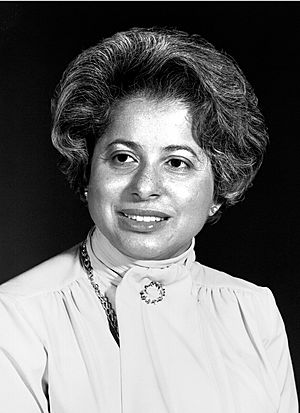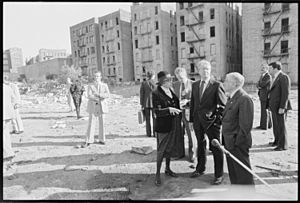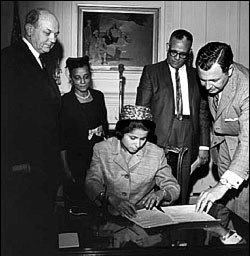Patricia Roberts Harris facts for kids
Quick facts for kids
Patricia Roberts Harris
|
|
|---|---|
 |
|
| 13th United States Secretary of Health and Human Services | |
| In office August 3, 1979 – January 20, 1981 |
|
| President | Jimmy Carter |
| Preceded by | Joseph A. Califano Jr. (Health, Education, and Welfare) |
| Succeeded by | Richard Schweiker (Health and Human Services) Shirley Hufstedler (Education) |
| 6th United States Secretary of Housing and Urban Development | |
| In office January 23, 1977 – September 10, 1979 |
|
| President | Jimmy Carter |
| Preceded by | Carla Anderson Hills |
| Succeeded by | Moon Landrieu |
| United States Ambassador to Luxembourg | |
| In office September 7, 1965 – September 22, 1967 |
|
| President | Lyndon B. Johnson |
| Preceded by | William R. Rivkin |
| Succeeded by | George J. Feldman |
| Personal details | |
| Born |
Patricia Roberts
May 31, 1924 Mattoon, Illinois, U.S. |
| Died | March 23, 1985 (aged 60) Washington, D.C., U.S. |
| Resting place | Rock Creek Cemetery Washington, D.C., U.S. |
| Political party | Democratic |
| Spouse |
William Harris
(m. 1955; died 1984) |
| Education | Howard University (BA) University of Chicago American University (MS) George Washington University (JD) |
Patricia Roberts Harris (May 31, 1924 – March 23, 1985) was an important American leader. She was a politician, a diplomat, and a legal expert. She made history by being the first African American woman to serve in a presidential cabinet. This is a group of top advisors to the President.
Patricia Harris served as the Secretary of Housing and Urban Development from 1977 to 1979. Later, she became the Secretary of Health and Human Services from 1979 to 1981. Both of these jobs were under President Jimmy Carter. Before that, she was the United States Ambassador to Luxembourg from 1965 to 1967, appointed by President Lyndon B. Johnson.
She was also the first Black American woman to be the head (dean) of a law school. Plus, she was the first Black American woman to join the board of directors for a major company like those on the Fortune 500 list.
Contents
Early Life and Family Background
Patricia Roberts was born on May 31, 1924, in Mattoon, Illinois. Her father, Bert Fitzgerald Roberts, worked on railroad dining cars. Her mother was Hildren Brodie. Patricia had one younger brother named Malcolm.
When Patricia was six years old, her parents separated. She was mostly raised by her mother and grandmother. She went to public schools in Chicago.
Education and Early Activism
Patricia was a very bright student. She earned scholarships to five different colleges! She chose Howard University and graduated in 1945 with top honors. While at Howard, she was part of Phi Beta Kappa, an honor society. She also helped lead the Howard University chapter of the NAACP, a group that works for civil rights.
She was also a member of Delta Sigma Theta, a sorority for Black women. In 1943, she took part in one of the first "lunch counter sit-ins." This was a protest where people sat at segregated lunch counters to fight for equal rights.
After Howard, she studied industrial relations at the University of Chicago from 1946 to 1949. To get more involved in civil rights, she moved to American University in 1949. There, she earned her Master's Degree.
In 1955, Patricia married William Beasley Harris. She wanted to work in education, but segregation made it hard for Black people to find good jobs. Her husband encouraged her to go to law school. She earned her law degree from the George Washington University National Law Center in 1960. She was the top student in her class of 94! She passed the bar exam that same year.
A Career of Firsts and Leadership
While studying, Patricia worked for the Young Women's Christian Association. She also worked for the American Council on Human Rights from 1949 to 1953.
Her first job with the U.S. government was in 1960. She became an attorney in the criminal division of the United States Department of Justice. There, she became friends with Robert F. Kennedy, who was the Attorney General.
Teaching and Civil Rights Work
A year later, Harris became a lecturer and Associate Dean of Students at Howard University. She stopped being a Dean in 1963 but continued teaching. From 1962 to 1965, she also worked with the National Capital Area Civil Liberties Union.
Patricia Harris became very active in the Democratic Party. In 1963, she became a full professor at Howard. President John F. Kennedy chose her to co-chair the National Women's Committee for Civil Rights. This group brought together about 100 women's organizations across the country.
Becoming an Ambassador
In 1964, Harris was chosen as a delegate for the Democratic National Convention from Washington, D.C.. She helped with Lyndon B. Johnson's presidential campaign. In October 1965, President Johnson appointed her as the United States Ambassador to Luxembourg. She was the first African American woman to be an American ambassador.
She said she was proud to be chosen to "knock down this barrier." But she also felt a little sad that she was the "first Negro woman," because it showed that Black women hadn't been considered for such roles before. President Johnson also named her as a delegate to the United Nations General Assembly from 1966 to 1968.
Law and Corporate Boards
In 1967, Harris returned to the Howard University's School of Law. In 1969, she was named Dean, another first for a Black woman. She resigned a month later because she disagreed with the university president about how to handle student protests. She then joined a well-known law firm in Washington, D.C., called Fried, Frank, Harris, Shriver & Jacobson.
In 1971, Harris joined the board of directors for IBM. This made her the first Black American woman to serve on the board of a Fortune 500 company. She also served on the boards of other big companies like Scott Paper, the National Bank of Washington, and Chase Manhattan Bank.
She noted that there were not enough Black people in leadership roles. She believed that large companies could help change this. She said, "I'm a first on many boards, but I'm not going to be content to remain the only black, or the only woman."
Harris continued to be important in the Democratic Party. In 1972, she led the credentials committee. In 1973, she became a member of the Democratic National Committee. Her hard work and excellence led President Jimmy Carter to appoint her to two very high-level positions in his administration.
Serving in the President's Cabinet

When President Jimmy Carter took office in 1977, he appointed Patricia Harris as the United States Secretary of Housing and Urban Development (HUD). At her confirmation hearing, a senator questioned if she was too wealthy to understand the needs of people HUD served.
Harris famously replied, "I am a black woman, the daughter of a Pullman car waiter. I am a black woman who even eight years ago could not buy a house in parts of the District of Columbia. I didn't start out as a member of a prestigious law firm, but as a woman who needed a scholarship to go to school. If you think I have forgotten that, you are wrong."
Her appointment was approved easily. Harris became the first African American woman to be in the U.S. Presidential line of succession. She served as HUD Secretary from 1977 to 1979. She worked to improve neighborhoods by providing funding and programs to rebuild cities.
Because of her success at HUD, President Carter appointed her as the United States Secretary of Health and Human Services in 1979. This was the largest Cabinet agency. She managed budget challenges and improved the department's leadership team. She remained Secretary until President Carter left office in 1981.
Later Life and Legacy
In 1981, Patricia Harris became a full-time professor at the George Washington University Law School. She taught there until she passed away in 1985.
She ran for Mayor of Washington, D.C. in 1982 but lost the election. One reason for her loss might have been that Washington, D.C., had never elected a female mayor before. However, the city's first female mayor, Sharon Pratt, actually worked as Harris's campaign manager!
Personal Life and Passing
Patricia Roberts met William Beasley Harris while working at the American Council on Human Rights. They married on September 1, 1955. William later became a federal judge.
Patricia Harris was a member of the Delta Sigma Theta sorority. She also served as its first national executive director for six years. She enjoyed cooking and baking in her free time.
Her husband, William, passed away in November 1984. Patricia Roberts Harris died on March 23, 1985, at the age of 60, from breast cancer. She was buried at the Rock Creek Cemetery in Washington, D.C.
Lasting Impact
After her death, a special program was created in her honor at Howard University. It's called the Patricia Roberts Harris Public Affairs Fellowship. It helps students get internships in public affairs. Since 1987, over 200 students have benefited from this program.
On January 27, 2000, the United States Postal Service released a special stamp honoring Patricia Harris. It was part of their Black Heritage Series. In 2003, Harris was also added to the National Women's Hall of Fame. Her life showed that with hard work and determination, barriers can be broken down.
See also
 In Spanish: Patricia Roberts Harris para niños
In Spanish: Patricia Roberts Harris para niños
- List of African-American firsts
- List of African-American United States Cabinet members
- List of female United States Cabinet members
- List of people who have held multiple United States Cabinet-level positions


